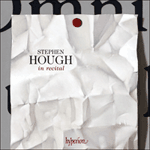Liszt wrote some delightful waltzes when he was in his twenties and early thirties—
Valse de bravoure,
Valse mélancolique,
Valse-Impromptu—and then more or less abandoned dance forms for forty years. So it has long been assumed that the four
Valses oubliées which he produced in his seventies were inspired by some kind of nostalgia for his carefree youth. Although the title (‘Forgotten Waltzes’) seems to confirm that assumption and although there is the occasional sentimental episode, the
Valses oubliées are actually not so much nostalgic as ironic. Obviously, they do not display the demonic attitude of the Mephisto Waltzes but they all have something sardonic about them—even the most popular of them, No 1 in F sharp major, which is characterized by the impish rhythms in the opening bars, the pressure put on the initially charming main theme, the feverishly glittering second theme in high right-hand octaves, the inconclusive ending.
from notes by Gerald Larner © 2009
Liszt avait une vingtaine et une bonne trentaine d’années quand il signa quelques valses ravissantes—
Valse de bravoure,
Valse mélancolique,
Valse-Impromptu—, puis il abandonna plus ou moins les formes de danse durant quarante ans. Aussi a-t-on longtemps supposé que les quatre
Valses oubliées qu’il produisit vers soixante-dix ans lui furent inspirées par une manière de nostalgie pour sa jeunesse insouciante. Même si leur titre semble abonder en ce sens, et même si elles renferment le traditionnel épisode sentimental, elles ne sont, au vrai, pas tant nostalgiques qu’ironiques. Certes, elles n’arborent pas l’attitude démoniaque des
Méphisto-Valses, mais elles ont quelque chose de sardonique—y compris la plus populaire, la no 1 en fa dièse majeur, marquée par les rythmes taquins de ses premières mesures, la pression exercée sur son thème principal, d’abord charmant, son second thème étincelant en octaves aiguës à la main droite et sa conclusion peu probante.
extrait des notes rédigées par Gerald Larner © 2009
Français: Hypérion
Liszt schrieb in seinen Zwanzigern und frühen Dreißigern mehrere gefällige Walzer—
Valse de bravoure,
Valse mélancolique,
Valse-Impromptu—und wandte sich dann in den nächsten 40 Jahren von Tanzformen mehr oder minder völlig ab. Deshalb ging man lange davon aus, dass die vier
Valses oubliées, die er in seinen Siebzigern komponierte, in einem Anflug von Sehnsucht nach seiner sorgenfreien Jugend entstanden seien. Obwohl der Titel („Vergessene Walzer“) dies zu bestätigen scheint und auch verschiedene sentimentale Passagen erklingen, sind die
Valses oubliées nicht so sehr als nostalgisch, sondern eher als ironisch zu charakterisieren. Natürlich sind sie nicht so teuflisch angelegt wie die Mephisto-Walzer, aber sie haben doch alle ein gewisses dämonisches Element, selbst der beliebteste, der Walzer Nr. 1 in Fis-Dur, der mit schelmischen Rhythmen beginnt und in dem das zunächst liebliche erste Thema, das fieberhaft glänzende zweite Thema in den hohen Oktaven der rechten Hand und der ergebnislose Schluss betont werden.
aus dem Begleittext von Gerald Larner © 2009
Deutsch: Viola Scheffel


 Liszt: Complete Piano Music
Liszt: Complete Piano Music Stephen Hough in recital
Stephen Hough in recital
